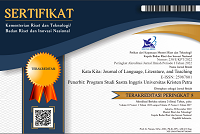MIA’S PSYCHOPATHY IN MOULY SURYA’S FIKSI
(1) English Department, Faculty of Letters, Petra Christian University Siwalankerto 121-131, Surabaya 60236, East Java
(2) English Department, Faculty of Letters, Petra Christian University Siwalankerto 121-131, Surabaya 60236, East Java
(*) Corresponding Author
Abstract
This study aims to discuss Mia’s psychopathic symptoms through the 18 items described in Psychopathy Checklist—Revised four-factor model. The purpose of this analysis is to discuss what psychopathic category Mia belongs to and to discuss why Mia, as a psychopathic person, commits suicide. The analysis shows that Mia’s psychopathic symptoms fit these factors, and through it, the score can be given to each item discussed in the analysis. Moreover, it also shows that one of the factors, which is the factor of lifestyle, affects the probability of a psychopath to commit suicide because of the impulsivity that a psychopath has. In the end, it can be concluded that Mia is a psychopathic person who can be categorized as an intermediate psychopath, and her suicidal act is affected by her past traumatic experience and her impulsivity.
Keywords
Full Text:
PDFReferences
Babiak, P., & Robert H. (2006). Snakes in Suits.
Cleckley, H. (1976). The Mask of Sanity. Cassiopaea. Retrieved from www.cassiopaea.org/cass/sanity_1.PdF
Dunn, S. (2011, April). MOTIVES FOR LYING: a deliberate choice to mislead a target without giving any notification of the intent to do so. Linked in corporation. Retrieved from ttp://www.linkedin.com/groups/MOTIVES-LYING-Lying-deliberate-choice-3164794.S.52247712
Hare, R. (2012, December). This Charming Psychopath. Psychology today. Retrieved from http://www.psychologytoday.com/articles/199401/charming-psychopath
Negredo, L., Melis F., & Herrero O. (2013). Psychopathy and suicidal behaviour in a sample of mentally disordered offenders. Rev ESP Sanid Penit 15, 3-7. http://johnjayresearch.org/rec/files/2013/07/negredo2013.pdf
Patrick, C. (2007). Affective Processes in Psychopathy. In Rotterneberg J., & Johnson S. L. (Ed.), Emotion and Psychopathology: Bridging Affective and Clinical Science (pp. 215-239). America: American Psychological Association.
Psychopathic traits. Retrieved from
http://www.sociopathicstyle.com/psychopathic-traits/>
Thriller. Retrieved from http://thescriptlab.com/screenplay/genre/thriller
Torto, G. (2013, October). The Art of Lying. The Situation Features. Retrieved from http://www.thesituation.co.uk/features/05/lying/lying.html
Wynn, R., Hoseith, M., & Pettersen, G. (2012). Psychopathy in women: theoretical and clinical perspectives. International Journal of Women’s Health 4, 257-263. http://www.ncbi.nlm.nih.gov/pmc/articles/PMC3379858/
Verona, E., Joiner, T. E., & Patrick, C. J. (2001). Psychopathy, antisocial personality, and suicide risk. American Psychological Association 110.3, 462-470. http://www.ncbi.nlm.nih.gov/pubmed/11502089
Weaver, M. (2006). Two-, Three-, and Four Factor PCL-R Models in Applied Sex Offender Risk Assesment. SAGE Journals 13, 208-216. http://asm.sagepub.com/content/13/2/208.abstract
DOI: https://doi.org/10.9744/katakita.2.1.%25p
Refbacks
- There are currently no refbacks.
Supported by:
Indexed in:
Tools:
Stats (installed since 17 December 2018)
View My Stats













